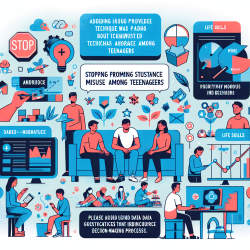Introduction
Substance abuse among adolescents is a persistent public health challenge, exacerbated by the recent opioid crisis. The susceptibility of the adolescent brain to substance abuse makes prevention efforts critical. A recent review titled Preventing Substance Abuse in Adolescents: A Review of High-Impact Strategies provides valuable insights into evidence-based prevention programs (EBPPs) that have shown significant promise in reducing substance use among youth. This blog explores these strategies and encourages practitioners to adopt data-driven approaches for effective outcomes.
The Adolescent Brain: A Window of Vulnerability
Adolescence is a period of significant brain development, characterized by increased susceptibility to drug use due to changes in the prefrontal cortex, striatal cortex, and limbic system. These neuroanatomical changes make adolescents more prone to making decisions based on emotion and immediate rewards, increasing their likelihood of experimenting with drugs. The review highlights the long-lasting impacts of substance use during adolescence, emphasizing the need for targeted prevention efforts.
Evidence-Based Prevention Programs
The review identifies five EBPPs with the highest benefit-cost ratios (BCR) that can be effectively implemented to prevent substance abuse among adolescents:
- Functional Family Therapy (FFT): A selective program targeting at-risk adolescents, FFT is a strength-based family counseling approach with a BCR of $18.75 and a 100% predictability rating, indicating near certainty of success.
- LifeSkills Training (LST): A universal program designed for middle school students, LST provides training in personal self-management, social skills, and drug resistance, with a BCR of $13.49 and a 63% predictability score.
- Positive Action (PA): Based on the philosophy that positive actions lead to positive feelings, PA has a BCR of $29.32 and a 94% predictability score, making it a highly effective universal intervention.
- Good Behavior Game (GBG): Originally a classroom management strategy, GBG has a BCR of $62.80 and a 76% predictability score, demonstrating its effectiveness in reducing aggressive behavior and subsequent substance use.
- Positive Family Support (PFS): Targeted at at-risk middle school-aged children, PFS covers all levels of intervention with a BCR of $197.66 and a 70% predictability score, emphasizing the importance of family dynamics in prevention efforts.
Encouraging Data-Driven Decisions
For practitioners, the implementation of these EBPPs offers a data-driven approach to substance abuse prevention. By focusing on programs with proven efficacy and economic benefits, schools and communities can make informed decisions that maximize positive outcomes for adolescents. The review provides a comprehensive analysis of these programs, offering a roadmap for successful implementation.
Conclusion
Addressing adolescent substance abuse requires a multifaceted approach that incorporates evidence-based strategies. The programs highlighted in the review offer effective solutions with significant societal benefits. By leveraging these insights, practitioners can create supportive environments that reduce the appeal of substances and foster healthy development among youth.
To read the original research paper, please follow this link: Preventing Substance Abuse in Adolescents: A Review of High-Impact Strategies.










